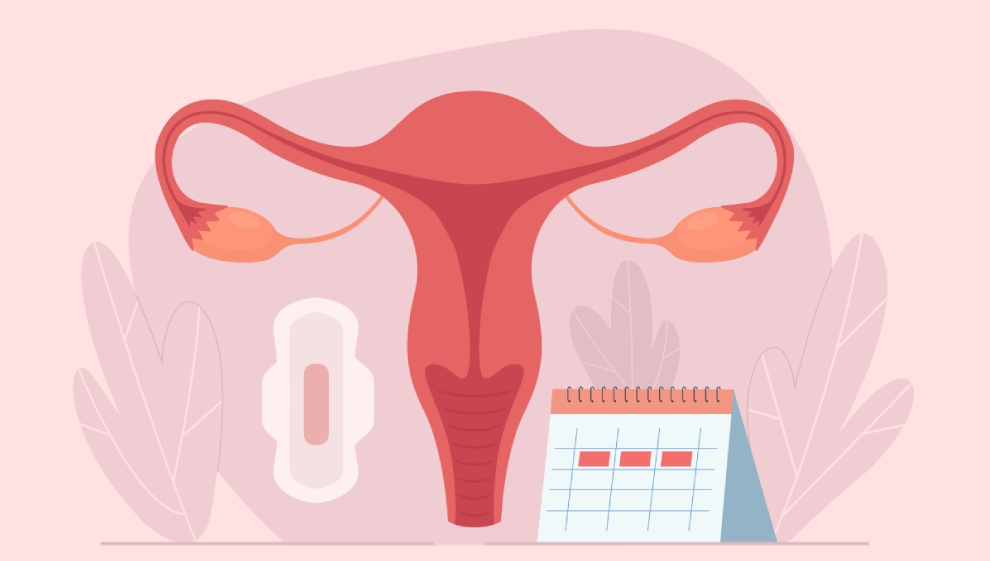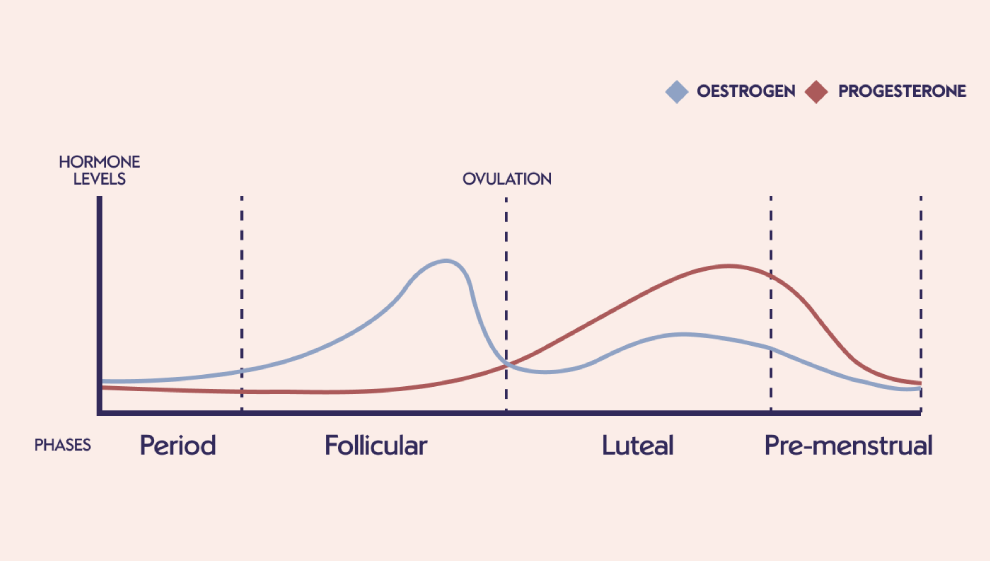Understanding the Menstrual Cycle | More than just your period
- Overview
What is the menstrual cycle?

The menstrual cycle is a natural process that occurs in the reproductive system of females, typically beginning in adolescence (around the age of 12) and continuing until the onset of menopause.
It involves a series of hormonal and physiological changes that prepare the body for pregnancy.
It’s often taught that the menstrual cycle lasts 28 days when in reality only 13% of females report having a 28-day cycle. The length of the cycle commonly ranges from anywhere between 21 and 35 days.
This can extend closer to 40 days in teenagers. The average woman spends 40 years of her life with a menstrual cycle. That adds up to approximately 450 cycles.
The menstrual cycle is controlled by several key hormones (oestrogen and progesterone), which are mainly produced by the ovaries.
The cycle is divided into four main phases: menstruation, the follicular phase, ovulation, and the combined luteal and premenstrual phase, all of which are expanded on in detail below.
What is the function of the menstrual cycle?
The menstrual cycle is a biological function designed to prepare the female body for pregnancy. Because of our subconscious drive to procreate, each month the body prepares for a pregnancy. This involves fluctuating hormones signalling the release of an egg and the thickening of the womb lining. If the egg is not fertilised by sperm, the body signals the shedding of the thickened womb lining and swiftly starts preparing for the next cycle.
What is menstruation?
Menstruation (or your period) is the part of the menstrual cycle where a woman bleeds from the vagina for a few days. This period tends to occur once every 28 days, however variations affected by a range of lifestyle and biological factors mean there is great variation regarding timing. For example, it’s equally as common for a woman to have their period once every 23 days or once every 35 days.
Focusing on the actual ‘period’ stage of the cycle is common, as it may be at the front of the mind since it’s what females see and deal with each month. However, it’s important to understand that the menstrual cycle is so much more than just your period – it’s a whole cycle of hormonal fluctuations which, when healthy, should happen predictably each month.
Hormones, hormones, hormones

The menstrual cycle is controlled and maintained by four main hormones.
These hormones are responsible for orchestrating all four phases of the cycle and instruct the ovaries to release an egg during ovulation.
These four hormones are:
- Follicle stimulating hormone (FSH)
- Luteinising hormone (LH)
- Oestrogen
- Progesterone.
The diagram shows how oestrogen and progesterone fluctuate during the four main phases of the menstrual cycle.
Phase 1: the menstruation phase (period)
What is the period?
Menstruation, or the period, refers to the lining of the uterus leaving the body in the form of blood and tissue. The first day of bleeding marks the first day or the start of your cycle. When tracking periods, the length of a cycle is counted from the first day of bleeding up until the day before the next period starts.
What to expect
- Menstruation – bleeding from the vagina
- Accompanying symptoms – these differ from woman to woman but commonly include abdominal cramps, bloating, stomach pain, headaches, back pain, mood changes and fatigue
- Inflammation – inflammation is high during menstruation, which can affect recovery from exercise
- Increased risk of illness – you may find your immune system is weaker when menstruating.
Practical tips
- Medication – taking anti-inflammatories and painkillers proactively can help minimise pain
- Self-care – consider applying heat to your stomach and back or taking a warm bath
- Exercise – low-intensity exercises like yoga and Pilates can help release tension in your muscles
- Nutrition – consider whether you have any diet triggers that may make symptoms worse.
Signs of a healthy period
If you’re concerned about the length of your period, know that it’s normal for bleeding to last up to eight days. The first day usually sees the heaviest blood flow, and flow typically becomes lighter as the period continues.
Having a healthy period is a helpful contributing factor to look out for when analysing overall bodily health and function for a female. It is one of many signs that your diet is or isn’t providing sufficient fuel for the body.
There are times where consulting your GP is recommended. These include:
- If your periods are absent for more than three months
- If your flow is so heavy that it can’t be managed without frequent changes of period products (every two hours or less)
- If your period is more than eight days
- If there are any sudden drastic changes to your cycle that you aren’t sure about
- If you have bleeding between periods.
Remember that it’s normal for a cycle to change throughout a female’s lifetime. Cycle symptoms and duration are often more severe during adolescence and can change a lot after giving birth.
Phase 2: the follicular phase
What is the follicular phase?
During the follicular phase of the cycle, the pituitary gland in your brain releases FSH, which encourages the egg cells in the ovaries to grow. As the eggs mature, the follicles in which they grow release oestrogen. It’s this hormone that rises to its peak in the first half of the cycle, just before ovulation.
Oestrogen has many functions, the most important of which is encouraging the build-up of the uterus (womb) lining which prepares the body for the implantation of a fertilised egg.
The follicular phase is the time during which eggs are produced in the ovaries. When oestrogen levels reach their peak, the brain starts producing LH, which lets the ovary know it’s time to release the most mature, dominant egg. At this stage, the egg cell bursts out of its follicle and through the ovary wall. This is what we call ovulation.
What to expect
- A small burst of testosterone – if you’re looking to strength train, this is a great time to do as you may have more potential for muscle adaptations
- Increased recovery capability – your body’s ability to recover from training might be improved
- Higher levels of oestrogen – this means there is a slightly increased risk of injury to ligaments and tendons due to increased laxity.
Practical tips
- Increased energy and drive – during the follicular stage of your menstrual cycle, you should feel energized and inspired, so this is a great time to get things done as the surge in testosterone increases motivation, energy levels and inspiration
- A great opportunity to exercise – you might find you are able to squeeze a little extra out of your exercise sessions because of the surge of hormones increasing your motivation/training ability.
Phase 3: the ovulation phase
The ovulation phase begins when the dominant egg is released from the ovary in preparation for potential fertilisation. This typically occurs in the middle of the cycle around day 14.
This released egg can only live for 24 hours, however sperm can survive in the vagina for up to six days. This means fertilisation and pregnancy can still occur if you have sex up to six days before ovulation occurs.
A common misconception is that the ovary responsible for releasing the egg alternates every month. The reality is that both the left and right ovary can release an egg and that the choice of ovary is random.
What to expect
- Increased body temperature – your body temperature will rise by about half a degree just after you ovulate, because sperm prefers warmer temperatures. A slightly higher body temperature can have a detrimental effect on exercise and endurance
- A softer, more open cervix – blood flow to the uterus peaks and the cervix opens to welcome the sperm in anticipation of pregnancy so it’s normal to experience more egg white-like discharge that is designed to help support the sperm.
Practical tips
- Prioritise hydration – as your body temperature increases, be more wary of drinking sufficient fluids to stay hydrated.
Phase 4: the luteal and premenstrual phase
After leaving the ovary, the dominant egg travels along the fallopian tube. This is the bridge between the ovary and the uterus. If fertilisation does not occur within 24 hours, the egg will die and the body will begin preparation for the next menstrual cycle.
The empty follicle that housed the egg during this process turns itself into a temporary gland called the corpus luteum. This gland starts to produce progesterone while continuing to raise levels of oestrogen.
What to expect
- High progesterone – the hormone progesterone is at its peak, which is associated with enhanced mood and lower anxiety
- Enhanced recovery – progesterone promotes sleep, meaning rest and recovery may feel easier when this hormone is high.
Practical tips
- Light stretching – yoga and Pilates are a great way to soothe muscle tension and focus your mind/body connection.
If the released egg is fertilised, the corpus luteum gland will go on producing progesterone until around eight weeks into pregnancy. If a fertilised egg isn’t implanted into the uterus, the corpus luteum will stop producing progesterone and oestrogen. When an egg isn’t fertilised, these hormones fall rapidly from their peak.
This decline in hormone production is the signal for the uterus lining, which has been building up to accept a fertilised egg, to be shed so the body can start to rebuild the lining for the next cycle. This shedding marks the end of your menstrual cycle.
What to expect
- A range of symptoms – PMS can be the most symptom-laden phase of the cycle for some women, with irritability, anxiety and a desire for comfort food all being perfectly normal
- Fatigue – if fatigued, watch your nutrition and fill your diet with healthy, energising foods
- Breast pain – pain in the chest area is common so ensure a good fitting bra and always use a sports bra for activity.
Practical tips
- Meal timing – space meals out evenly to stabilise blood sugar levels
- Exercise – restorative exercise like yoga, low-intensity aerobic exercise can be helpful
- Nutrition – ensuring you’re getting enough magnesium, zinc, calcium, vitamin D in your food, and avoid alcohol and caffeine wherever possible.
Last updated Tuesday 8 August 2023
First published on Thursday 27 July 2023

